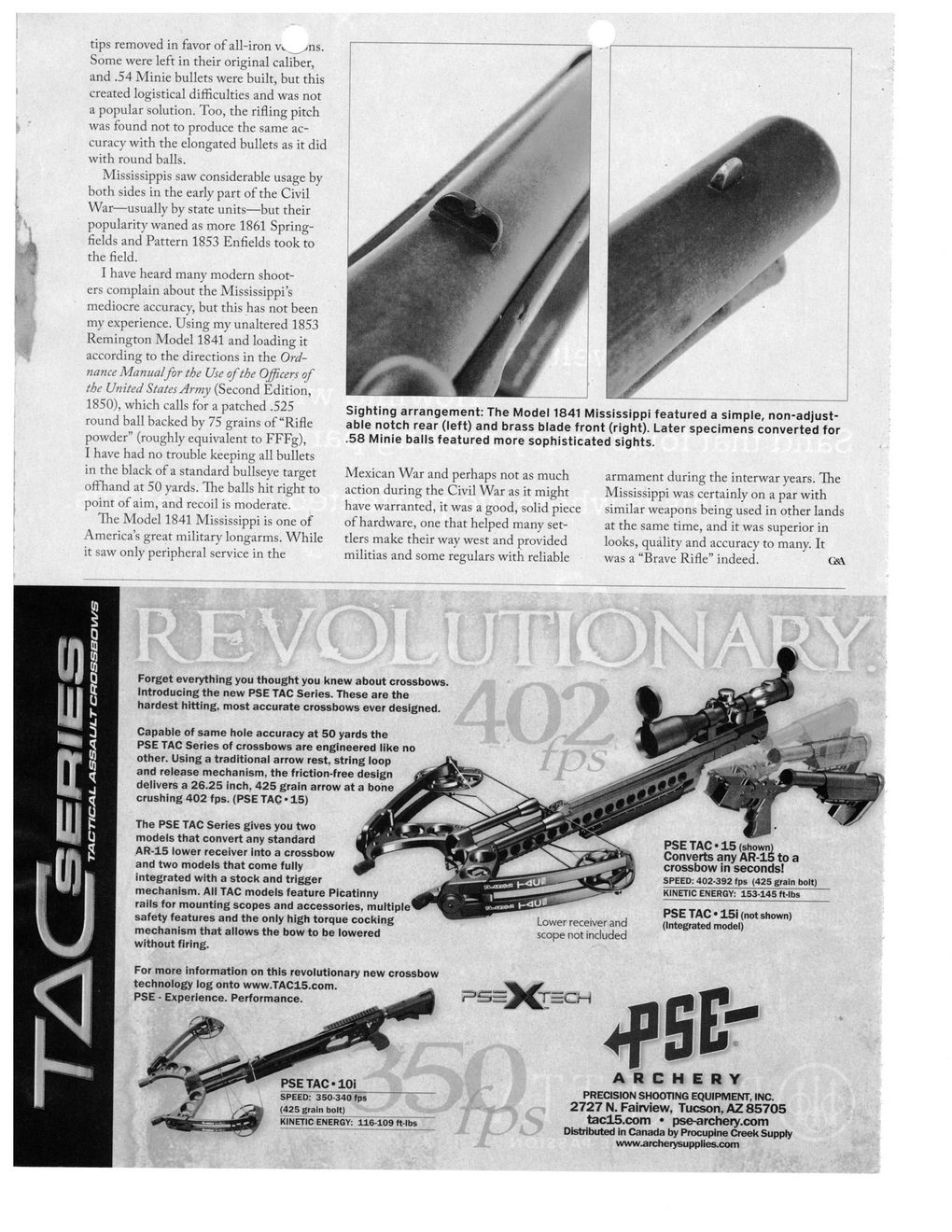This text was obtained via automated optical character recognition.
It has not been edited and may therefore contain several errors.
Sighting arrangement: The Model 1841 Mississippi featured a simple, non-adjust-able notch rear (left) and brass blade front (right). Later specimens converted for .58 Minie balls featured more sophisticated sights. tips removed in favor of all-iron v<^>ns. Some were left in their original caliber, and .54 Minie bullets were built, but this created logistical difficulties and was not a popular solution. Too, the rifling pitch was found not to produce the same accuracy with the elongated bullets as it did with round balls. Mississippis saw considerable usage by both sides in the early part of the Civil War—usually by state units—but their popularity waned as more 1861 Spring-fields and Pattern 1853 Enfields took to the field. I have heard many modern shooters complain about the Mississippi’s mediocre accuracy, but this has not been my experience. Using my unaltered 1853 Remington Model 1841 and loading it according to the directions in the Ordnance Manualfor the Use of the Officers of the United States Army (Second Edition, 1850), which calls for a patched .525 round ball backed by 75 grains of “Rifle powder” (roughly equivalent to FFFg), I have had no trouble keeping all bullets in the black of a standard bullseye target offhand at 50 yards. The balls hit right to point of aim, and recoil is moderate. The Model 1841 Mississippi is one of America’s great military longarms. While it saw only peripheral service in the Mexican War and perhaps not as much action during the Civil War as it might have warranted, it was a good, solid piece of hardware, one that helped many settlers make their way west and provided militias and some regulars with reliable armament during the interwar years. The Mississippi was certainly on a par with similar weapons being used in other lands at the same time, and it was superior in looks, quality and accuracy to many. It was a “Brave Rifle” indeed. CM Forget everything you thought you knew about crossbows, Introducing the new PSE TAC Series. These are the hardest hitting, most accurate crossbows ever designed. Capable of same hole accuracy at 50 yards the PSE TAC Series of crossbows are engineered like no other. Using a traditional arrow rest, string loop and release mechanism, the friction-free design delivers a 26.25 inch, 425 grain arrow at a bone crushing 402 fps. (PSE TAC • 15) The PSE TAC Series gives you two models that convert any standard AR-15 lower receiver into a crossbow and two models that come fully integrated with a stock and trigger mechanism. All TAC models feature Picatinny rails for mounting scopes and accessories, multiple* safety features and the only high torque cocking mechanism that allows the bow to be lowered without firing. For more information on this revolutionary new crossbow technology log onto www.TAC15.com. PSE - Experience. Performance. Lower receiver and scope not included PSE TAC • 15 (shown) Converts any AR-15 to a crossbow in seconds! SPEED: 402-392 fps (42S grain bolt) KINETIC ENERGY: 153-145 ft-lbs PSE TAC * 15i (not shown) (Integrated model) X PS=XT£CH PSE TAC • lOi SPEED: 350-340 fps (425 grain bolt) KINETIC ENERGY: 116-109 ft-lbs ^fSE- ARCHERY PRECISION SHOOTING EQUIPMENT. INC. 2727 N. Fairview, Tucson, AZ 85705 tacl5.com • pse-archery.com Distributed in Canada by Procupine Creek Supply www.archerysijpplies.com

Mississippi Rifle Document (005)